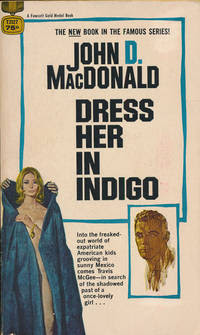Monday, January 10, 2022
Dress Her in Indigo by John D. MacDonald
More than 50 years after its publication, John D. MacDonald’s 1969 mystery, Dress Her in Indigo, provides a look back at the hippie era, a time that scared the crap out of parents of teenagers.
In this 11th book in the Travis McGee series, the daughter of a wealthy older man leaves college and goes to Mexico with a group of friends and dies in a car accident near Oaxaca.
The man asks McGee and his pal, Meyer, to leave South Florida and go there to find out what the girl was doing, what her life was like, and if she was happy.
(I don’t recall if McGee, the first person narrator, ever calls Meyer anything other than Meyer, or lets the reader know Meyer’s first name.)
McGee and Meyer hop a flight and get to work seeking out young Americans, asking about the girl, picking up her trail and learning about her “friends.”
Author MacDonald was about 52 or 53 when he wrote Dress Her in Indigo, so he, and his 40-ish protagonist, McGee, were the older generation observing the younger. While he tried to give the hippies the benefit of the doubt by painting some of them as lost and confused, or industrious artists doing their own thing, there was a distinct smell of disapproval coming off the pages.
Not that all bohemian types repelled McGee. At one point he hooks up with a slinky, rich European woman who lives for sex, and nearly kills him with her requirements in the sack. Meyer, too, finds some free love with a very young Mexican woman.
Soon, McGee uncovers disturbing facts about the dead girl’s car accident and starts digging into the case.
The mystery is less interesting than MacDonald’s portrait of the self appointed leader of the girl’s group, an intense, charismatic con man.
Was art imitating life here? Did MacDonald write the book after the Tate–LaBianca murders of August 1969. Or was MacDonald predicting this type of character emerging?
Subscribe to:
Post Comments (Atom)


No comments:
Post a Comment